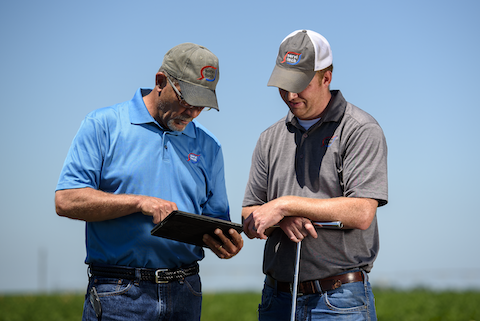Feedstuffs are grown, harvested, and stored under a variety of conditions that can dramatically affect quality. A representative feedstuff sample is the most important step in achieving accurate analysis. The following sampling procedures are common, recommended practices which help to obtain the most representative sample possible.
General Sampling Tips
- Use ServiTech feed sample bags or quart sized freezer zipper bags
- Clearly mark: name, sample id, specific feedstuff and desired testing
- Seal tightly. Protect from heat. Ship promptly.
- Plan sampling for shipment early in the week for quickest turnaround
Hay — Sample close to point of sale or feeding with enough time to plan with results.
Sample different cuttings, fields, types separately. Use hay probe with sharpened tip to core 15–20 random bales through the end of square bales or curved side of round bales. Do not hand-grab or quarter for sample reduction = potential leaf loss which alters nutrient value.
Pastures — Sample at peak growing season and forage dormancy.
Mimic livestock’s tongue to pull equal sized samples from 10-15 spots in pasture at grazing height. Separate pastures = separate samples.
Standing Forage — Beginning in May to determine when field is prime for cutting.
Begin collecting samples when forage is approx. 12–14in. Cut with scissors at cutter bar height (~3in) at a minimum of 6 random locations in one field.
Silage
At Harvest — Collect 2-3 handsful (palm up) as truck is unloading. Repeat for several loads from one field and combine into a single sample. Keep cool.
Finished silage (upright silo) — Begin sampling at feed out. Avoid collecting from very top and bottom. Catch 3-5 handsful while unloader is operating during morning feed, refrigerate, combine with evening feeding subsample for one test portion.
Finished silage (bunker silo) — Begin sampling at feed out.
** Exercise extreme caution when sampling from open face. Use the buddy system for safety.**
Divide face in thirds. Hand grab (palm up) from upper, middle and lower areas in all 3 sections avoiding surface crust. Mix in clean plastic bucket then use quartering method to reduce sample size.
Another option: allow face shaver or loader to pull down feed. Collect 6-9 handsful (palm up) from the mixed pile. Mix in clean plastic bucket then use quartering method to reduce sample size.
Grain, Bulk Feed, Ingredients — Collect 12-15 subsamples as grain/feed is discharged. Use grain probe or trier whenever possible. Mix and reduce sample size if necessary.
Ration from bunk — Sample before animals begin to eat. Hand grab (palm up) from top, middle and bottom in evenly spaced intervals from one end of the bunk to the other. Take care to not lose fines.
Quartering Process — For reduction in sample size while maintaining integrity of sample. Mix thoroughly. Pour onto clean paper or plastic. Divide into 4 equal parts - save two, discard two. If sample still too large, start again at mixing. Place entire quarter including all fines in bag for testing.

